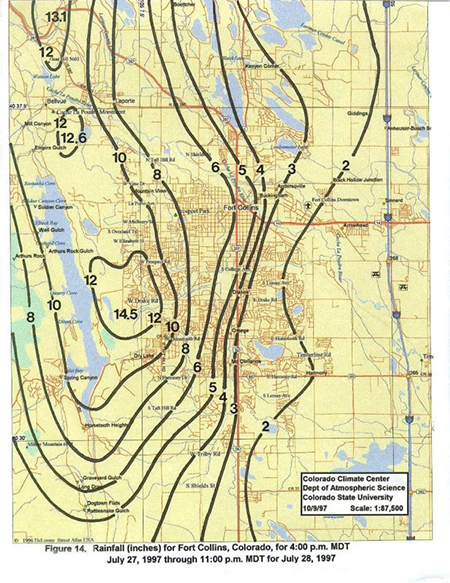Marking the anniversary of the 1997 Spring Creek Flood that inspired CoCoRaHS
This week marks the 25th anniversary of the Spring Creek Flood of July 27-28, 1997, when unprecedented extreme rainfall on the western edge of Fort Collins caused a flash flood that killed five residents and caused $140 million in damages to Colorado State University’s campus.
CSU’s Walter Scott, Jr. College of Engineering had a unique role in helping the community to move forward after the disaster.
Even as the waters receded from the Engineering building, two of the college’s departments were tapped to help the city understand what had happened, and what could be done to reduce the impact of similar storms in the future.
Atmospheric scientists, who research forecasting, detection and reporting of extreme weather, watched the storm develop from their vantage point on the Foothills Campus. Civil engineers, who study urban infrastructure for flood events, had front row seats as the waters inundated the lower levels of their own building.
Nolan Doesken, then assistant state climatologist and later state climatologist for 11 years, recalled that morning clearly. Heavy rains the night before had left the ground saturated. More storms were in the forecast, and one irrigation ditch he passed on the way to the Foothills Campus was already “full to the brim – fuller than I had ever seen it.”
A trusted volunteer had measured an astounding 10 inches of rain in nearby LaPorte. The sophisticated National Weather Service radars in the region showed nothing so remarkable. Faculty in the Atmospheric Science department were puzzled, recalled Doesken. “Where did all that rain come from, and how had it escaped detection by the world’s best national radar system?”
Read the full Source story, “Spring Creek Flood 25 years ago led to a national precipitation network, infrastructure upgrades.”
Image: A rainfall contour map from the storm shows dramatic variation in accumulations across short distances. Image courtesy of Colorado Climate Center.



